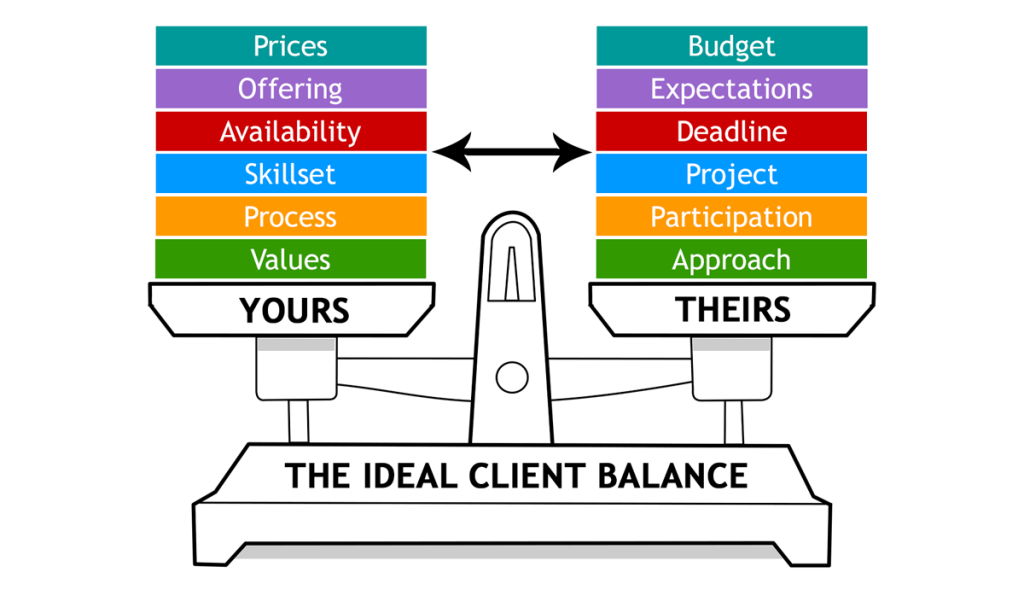Your website is attracting the wrong clients
You’re a service provider, working with clients. Your website is generating enquiries and you’re getting work. But something feels off and you’ve been going from one bad client relationship to another.
So what’s the problem?
It could be that you’re trying to appeal to everyone. And you’ve been focused on maximising your enquiries rather than attracting the best prospects for what you have to offer.
Truth is, you don’t need more enquiries — you need better ones.
There is a way to filter out these bad-fit clients before they even pick up the phone or start filling in your contact form. And it’s called repelling content.
Repelling content is like creating an exclusion zone around you. Like the picture above, but without the caution signs and razor wire.
What you really want are ideal clients
With an ideal client, everything clicks.
You’re aligned on everything, from your pricing to your process, and your values to your vision. And there’s mutual trust and respect.
I like to think of it like this:

A perfectly balanced scale with both parties getting exactly what they need from the working relationship.
Even if there’s some give and take in certain areas, the overall balance and relationship can still be good.
Most of the content I write for my clients is designed to attract ideal clients.
But not all clients are ideal
On the flip-side of your ideal client is the wrong client.
In this case, the scale doesn’t balance and either you or your client ends up losing out.
Maybe the client isn’t right for you. Perhaps they’re making unfeasible or unreasonable demands. Or they’re not respecting your expertise and insisting you work on their terms.
Maybe you’re not right for your client. Perhaps their project isn’t a good fit for your skills. Or what you’re offering isn’t suitable for their needs.
In either case, selling your services to a bad-fit prospect is a bad idea. You’ll find it comes with unwelcome challenges and stress. Your client won’t get what they want or need. Neither of you will be happy with the outcome and they might even give you a bad review.
Website content should work like a magnet
The content on your website should attract the good-fit prospects, who match with you and your services, and repel the bad-fit ones who don’t.


But it’s not as simple as good and bad
Some prospects aren’t so much a bad fit as they are uninformed. Educational and explainer content could change this.
For example, a prospect might automatically think your service is overpriced if it’s more than they want to pay. But the right content could educate them on the value you offer, so they can see how that justifies the price.
A prospect who doesn’t understand how your service works might try to bulldoze you into doing things their way. But a blog post that details your process and why it works so well could convince them your way is better.
What is repelling content?
Repelling content is created to pre-qualify your leads. Its purpose is to deter bad-fit prospects from contacting you or taking up your offers.
This might sound negative, but it’s more about clarity, transparency and alignment than outright telling your bad-fit prospects to go away. With messaging that defines your ideal balance and sets clear expectations and boundaries.
Obviously, repelling content isn’t foolproof, because you’re relying on your prospects finding it and reading it. But once you have the content, there are other ways you can use it. And I’ll get to those later.
How does repelling content work?
Repelling content works by showing bad-fit prospects how you won’t be a good match and explaining why not. The why not is important, because if they’re uninformed, it could help change their minds.
Even if what you’re offering isn’t for them, most prospects will appreciate your openness. It will save them the time and effort they might have spent contacting you. And it could even point them in a better direction for their needs.
It also shows you’re selective about who you choose to work with, which will make you more desirable to the good-fit prospects and less so to the bad-fit ones.
Practically, the content can do this in a number of ways.
For example by:
- Profiling the prospects who won’t benefit from working with you and why
- Being transparent and answering FAQs about your pricing
- Managing expectations by being upfront about what’s realistic
- Explaining why they might not be ready for what you’re offering
- Showing why your service won’t work for prospects like them.
How content writers write repelling content
So how do we create content that will turn those bad-fit prospects away?
We start by getting really clear on who you don’t want to work with. For this, you’ll need to revisit your past client traumas and recount everything that went wrong. Think of it like therapy. Or an exorcism.
Try to reconnect with the feelings you had at the time and be honest with yourself about your role in what went wrong. Could you have done things differently and might that have changed the outcome?
For example, did your client make you feel like a hired help rather than a trusted partner? If so, why do you think that was?
Some questions to think about
When you think about the wrong clients you’ve had, most of the issues will relate back to the weights on the ideal client balance I talked about at the beginning. So here are some questions you might think about to help redress that balance in the future.

Your pricing vs. client’s budget
Ask yourself these questions if you’ve had money misunderstandings or issues with price shoppers:
- What kinds of clients have pushed back on your pricing or asked for discounts?
- Did those projects end up feeling undervalued or draining? Why?
- What should prospects understand about your pricing before they contact you?
- How can you communicate your pricing and value more clearly and transparently?
Your offering vs. client’s expectations
Think about these questions if you’ve had issues with scope creep, or clients who’ve made incorrect assumptions about what you can do for them:
- Where have clients expected things outside your offer?
- What deliverables or results did they assume were included, but weren’t?
- What do you wish they’d understood before they worked with you?
- How can you manage your prospects’ expectations more effectively?
Your availability vs. client’s deadlines
Consider these questions if you’ve had clients wanting work completed in an impossibly short amount of time:
- Which projects have been stressful because of unrealistic deadlines or urgency?
- Why did the client assume their project could be completed in the given timeframe?
- Where might you have to cut corners to deliver a rushed project on time?
- How can you communicate the importance of allowing enough time?
Your skillset vs. client’s project
Ask yourself these questions if you took on a project outside your skillset and ended up out of your depth:
- Did you take on the project for your own reasons rather than your client’s?
- Did the client persuade you to take the project against your better judgement?
- What, in particular, made the project difficult or unfeasible for you?
- Is it possible your client felt they had to take back control of the project?
- Is there a more effective way to filter enquiries like this and avoid temptation?
Your process vs. client’s participation
Consider these questions if you’ve had clients who were difficult to work with and didn’t respect your process:
- What kind of clients made the process feel easy and collaborative?
- Which ones resisted, micromanaged, or ghosted on feedback?
- What behaviours signal that a client won’t follow your process?
- What boundaries or expectations could you make explicit in your marketing?
Your values vs. client’s approach
Ponder on these questions if you’ve had clients who weren’t aligned with your values and this caused problems in your working relationship:
- What attitudes or behaviours have clashed with your values?
- What do your best clients believe in or care about that makes working with them easy?
- What kind of approach or attitude do you never want to deal with again?
- How can you communicate your values clearly, so like-minded people contact you and misaligned ones don’t?
Bonus: your client’s readiness and fit
Think about your answers to these questions if you’ve worked with clients who weren’t ready* or gave you red flags from the start:
- What qualifies a prospect as ready to work with you? What do they need to have in place and why?
- Did you ignore any red flags or gut feelings in the beginning? What were they?
*For example, if they weren’t clear on what they wanted, didn’t have the budget, or couldn’t make the necessary commitment.
Using your answers
When you’ve completed this exercise, we can discuss your answers and think about our next steps.
Your main website messaging
We could start with the content on your main web pages and see how we can adapt your existing messaging to be more polarising. Prospects are more likely to read this than your blog posts, so it’s important to make sure it’s aligning and repelling effectively.
Blog content
Some repelling content works better as blog articles.
Using your answers, I’ll be able to generate some ideas for repelling content that will work to deter the clients you don’t want to work with.
We can discuss these ideas and decide which ones we want to use. I’ll then write the content so you can approve it.
How to use the content
Once you have the content, the first thing to do is publish it on your blog. This will give the article its own URL, so you can share it and link to it as you wish.
Where to share the content
As I said at the start, just having the repelling content on your blog isn’t foolproof. Because you can’t rely on your prospects looking for it, finding it, and reading it. Here are some other ways to share it.
Email list and socials
Some repelling content can be shared with your email marketing list and social media followers. For example, if you have an article that outlines the ideal conditions for working with you, that could be something these audiences will find useful.
Enquiries
If prospects contact you with enquiries, they’ll often have questions for you. The content will give them more full answers, with reasoning, so they can make an informed decision on whether you’re right for them.
On your website
You can place links to relevant content on your main website pages. For example, I have links to articles on my process and pricing just above my contact form. So prospects can go and check them out before they contact me.
Want to stop attracting the wrong clients?
I’m Jenny, I’m a freelance copywriter — and I’m a huge believer in the power of repelling content.
It’s cut my bad-fit enquiries to almost none, while attracting more of the clients I work with best.
And, with my help, it could do the same for you.
Want to create some repelling content together?
It’s easy to get in touch!

You might also like…
I’ve sneaked in some of my own repelling content here. Can you spot it?



